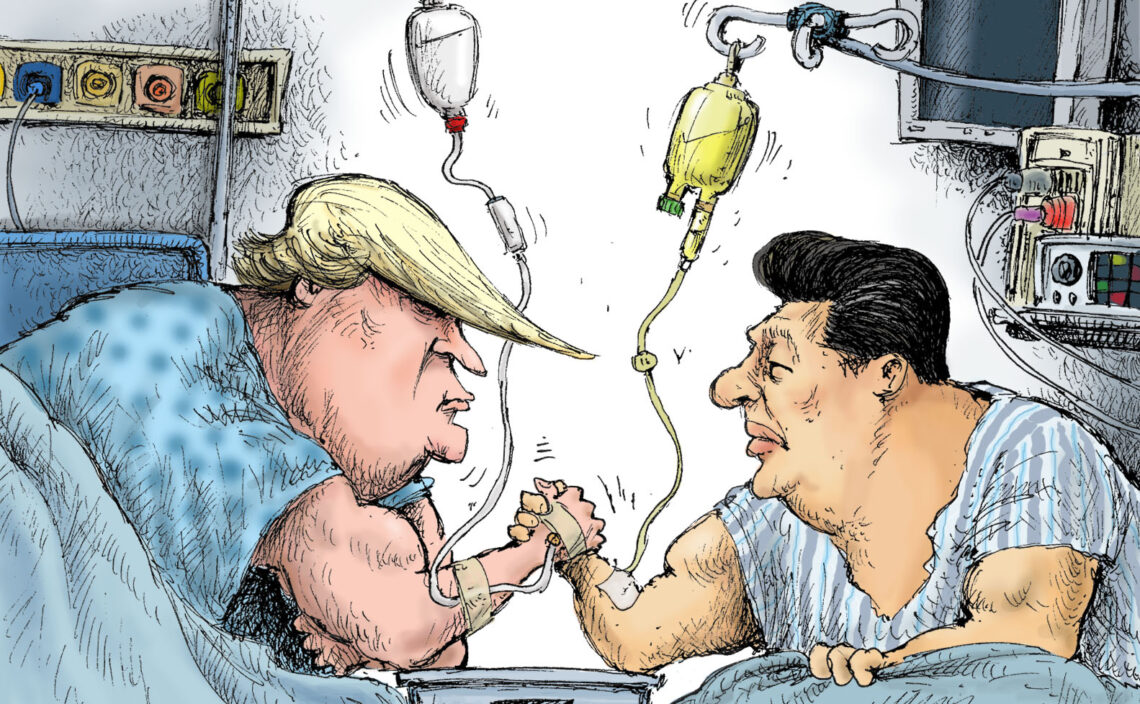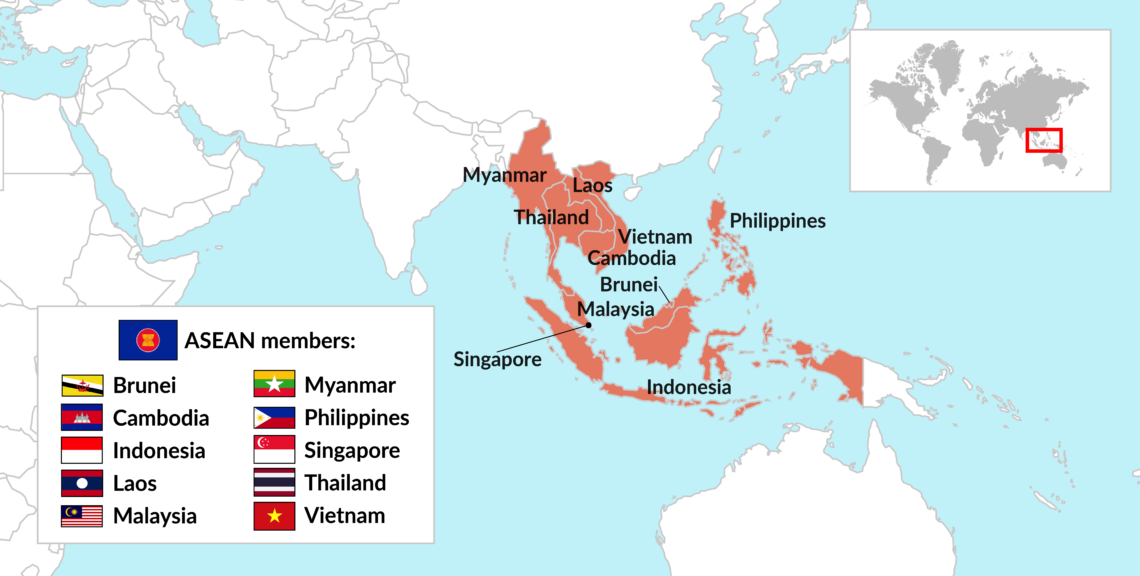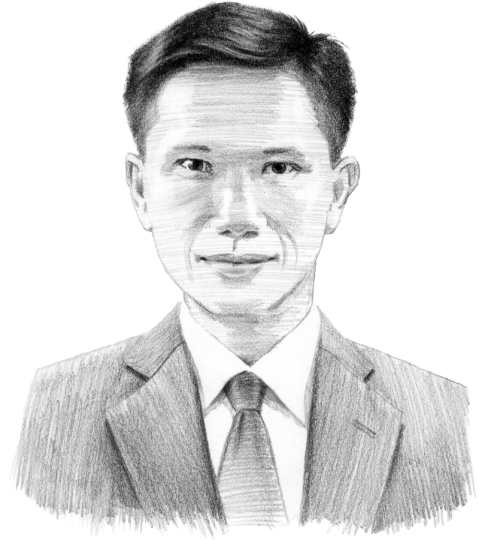The deepening geopolitical divide
If the 2008-2009 financial crisis launched China to superpower status, then the Covid-19 period may solidify its position. As the West continues to struggle with the fallout of the pandemic, the question will be who backs China, and who decides to oppose it.

In a nutshell
- The pandemic has deepened the global pro- and anti-China split
- The West continues to struggle with the fallout from the crisis
- New frictions could lead to an open conflict
This report is part of a GIS series on the consequences of the COVID-19 coronavirus crisis. It looks beyond the short-term impact of the pandemic, instead examining the strategic geopolitical and economic effects that will inevitably be felt further in the future.
China is front and center on the coronavirus stage. It was the first patient in and the first out of the global pandemic ward. The International Monetary Fund projects China’s economy will expand by 1.2 percent this year, down from the 6.5 percent growth it had forecast before the COVID-19 crisis hit.
Yet the United States, the European Union and much of the rest of the world are poised to register negative growth rates this year in what many see as the worst global economic contraction since the Great Depression. While China’s recovery has enabled a gradual reopening of its economy, Western criticism of China has risen sharply.
The upshot is a more divided international environment, where U.S. preeminence and prestige continue to wane while China’s reach and impact strengthen. China’s authoritarian rule and government-directed economic growth model stands in sharp contrast to the West’s emphasis on liberal values and free-market principles. The COVID-19 crisis has made that contrast starker.
As the geopolitical winds shift, the issue is which nations are with and against China.
After the 9/11 terrorist attacks, President George W. Bush admonished the countries of the world that they could be either with or against the U.S. As the geopolitical winds shift, the same could now be said about China. The answer can offer us insight into what will happen after the world comes to terms with the coronavirus.
Initial reactions
The paradigm shift caused by COVID-19 can be divided into three distinct stages. The first took place in January and February 2020, when the world watched in shock as Beijing imposed draconian lockdowns in Wuhan and other parts of China.
Reports of mismanagement by President Xi Jinping and the Chinese Communist Party (CCP) were rife. Critics of China’s system, like U.S. academic Minxin Pei, predicted the crisis could “topple” the CCP in a “coming upheaval.” The Wall Street Journal ran an in-depth series on the Chinese government’s virus bungles, particularly on its treatment of Dr. Li Wenliang, a whistleblower who died in early February after warning the public about, and subsequently contracting, the disease. Other reports pointed to posts expressing anger and disappointment toward authorities on Chinese social media.
In this early phase, the region was divided along the China fault line. Cambodia, Laos, Myanmar and Thailand chose to “suffer with” China in view of their giant neighbor’s influence in mainland Southeast Asia. Early on, none of these countries imposed restrictions on travel from China. Cambodia, Laos and Myanmar depend on China as a development lifeline for trade, investment and tourism.
Myanmar desperately needs China’s cooperation to help manage the ethnic conflicts in its northern states. Moreover, Beijing is underwriting the construction of a $6 billion rail link between Kunming in Yunnan province to the Laotian capital of Vientiane. The project is worth the equivalent of one-third of the landlocked country’s gross domestic product (GDP), and is part of the China-Indochina Peninsula economic corridor within Beijing’s colossal Belt and Road Initiative.
Facts & figures

Cambodia is the most important of Beijing’s client states. Its coastal Sihanoukville province is dominated by Chinese business interests and visitors, and is virtually a Chinese enclave bordering the South China Sea. To demonstrate loyalty, Cambodian Prime Minister Hun Sen visited Beijing in February, while the disease was running rampant in China.
Subsequently, China hosted a foreign ministers’ meeting with the Association of Southeast Asian Nations (ASEAN) in Vientiane to solicit regional solidarity on virus management. Instead, Beijing ended up chastising other countries, particularly Singapore and Vietnam, for having imposed early travel bans in late January.
Chinese visitors made up a third of Thailand’s 36 million tourists last year, when tourism accounted for 12 percent of the Southeast Asian nation’s GDP. This year, Thailand continued to receive Chinese tourists well into March. Since staging a military coup in May 2014, Thai Prime Minister Prayuth Chan-Ocha has kowtowed to China at the expense of his country’s relations with Western democracies.
The maritime ASEAN members that have prickly relations with China were in a different boat. They imposed travel restrictions on Chinese visitors and stepped up health measures to monitor nationals who visited China or came into contact with Chinese people.
Vietnam, like Taiwan, was vigilant early on, and was largely able to contain COVID-19. The dichotomy between mainland and maritime Southeast Asian countries toward China followed pre-pandemic patterns. The virus has simply deepened the divide among ASEAN member states.
Coronavirus diplomacy
A similar pro- and anti-China wedge has been evident in Europe. As China’s virus figures began to stabilize in mid-March, the pandemic went on a rampage in Europe and North America. Global coronavirus death and infection tallies became a league table of sorts, not only for public health management but also for each country’s ability to overcome the disease. Though China had the largest numbers at first, the U.S. and some European countries soon overtook it.
This second stage was about whether other pandemic-ravaged countries accepted China’s assistance and advice through its so-called “coronavirus diplomacy.” Beijing began to export medical equipment, expertise and experience. To date, more than a hundred countries have received China’s antivirus overtures with varying degrees of enthusiasm. European countries that participate in China’s Belt and Road Initiative, such as Italy, enthusiastically accepted Chinese aid. Southeast Asian governments have broadly welcomed Chinese medical gear and advice, but more so among mainland countries, especially Cambodia and Laos.
Public sentiment turned sympathetic to the CCP as the Chinese closed ranks in the face of Western criticism.
Some countries have pushed back hard. Spain and the Netherlands, for example, declined what they deemed “defective” Chinese test kits and face masks.
U.S. President Donald Trump, for his part, labeled the coronavirus a “Chinese virus,” and accused Beijing of spreading misinformation about the disease. He also suspended U.S. funding for the World Health Organization (WHO), which he accused of “mismanaging and covering up the spread of the coronavirus” to the benefit of China. Australia went a step further and called for an independent investigation into China’s virus mismanagement and the WHO’s role in it.
Still, China’s media manipulation has helped it spread its authoritarian tentacles over its people’s livelihoods and mindsets. Chinese leaders may have fumbled early on, but they quickly brought the situation under control. Public anger simmered but sentiment later turned sympathetic to the CCP as the Chinese closed ranks in the face of Western criticism.
On the other hand, many Western democracies have themselves mismanaged their response to COVID-19, particularly the U.S. Of the democracies that have successfully weathered the crisis, most are in East Asia: South Korea, Taiwan and Singapore, as well as Japan to a lesser extent. The disease has put the Western model of liberal democracy to the test.
Economic fallout
As partial re-openings take place in various countries from May, the third phase comes into play. The sharp economic contraction around the world will hit all economies hard but China’s centralized rule and large domestic market will likely give the country more room to manoeuvre. If the weaknesses of the U.S. and Europe in the 2008-09 financial crisis allowed China to launch to superpower status, the 2020-21 period may help it consolidate that position.
China is likely to come out of the crisis more intact than the other major powers because it suffered earlier and recovered faster.
Even though its growth this year will be much lower than forecast, China is likely to come out of COVID-19 more intact than the other major powers because it suffered earlier and recovered faster.
Scenarios
China’s new phase of ascendancy will split the international community between nations that recognize Beijing’s pre-eminence and those that resist it. In an ideal world, the coronavirus crisis would have galvanized international cooperation, led by China and the U.S., to fight a common enemy. The U.S.-China trade dispute could have faded into the background, giving way to a war fought by humanity against a lethal threat. Instead, the virus has worsened geopolitical tensions.
In one scenario, the deteriorating relationship between the U.S. and China could lead to an open conflict. As the coronavirus blame game between Washington and Beijing intensifies, such a scenario is more plausible than at any time in recent decades. China, for example, has expanded its claims in the South China Sea by setting up administrative regions – despite Vietnam’s opposition – while Washington and others are preoccupied with the pandemic. At the time of writing, nine U.S. plaintiffs, including the state of Missouri are suing China for its handling of the virus, while the Trump administration points to Beijing as the culprit behind America’s woes. Those charges could quickly become a casus belli if conditions take a turn for the worse. Naturally, China denies such accusations, which it considers global scapegoating and an effort to undermine inexorable geopolitical supremacy.
The two powers’ leaders have their own reasons for ratcheting up tensions. China’s economic slowdown will put President Xi Jinping under domestic pressure ahead of the CCP’s centennial anniversary next year, while President Trump faces an election in November. Both will want to shore up their popularity by employing nationalist rhetoric and finding outsiders to blame for domestic problems.
Since profound crises often lead to cathartic changes, another scenario would see political upheavals in both the U.S. and China that end with structural reforms and a realignment of their interests abroad. For example, President Trump could lose the election this year, while President Xi could be forced out or pressured to take a different tack by CCP cadres. Such changes might steer away from confrontation and toward peaceful coexistence and a revamped international order that satisfies both countries, with a more significant global role for China and a still satisfactory level of influence for the U.S.
By historical standards, the coronavirus pandemic has been run-of-the-mill so far, but the global impact of the media-induced hysteria has led governments to react disproportionately. If the geopolitical consequences of this mismatch between virus lethality and government responses turn out to be dire and unmanageable, the conflict scenario will become the most likely.








